In the 60-odd years that has seen the Central Tibetan Administration (CTA) milking the international community for every dollar they can, no other refugee community has been allowed to get away with shockingly low levels of financial transparency and accountability. The CTA, or the Tibetan leadership based in Dharamsala, exist on Indian soil but are never expected to show their accounts, pay taxes or otherwise contribute to the governance and welfare of India. Similarly, the multitude of Tibetan non-governmental organizations that raise funds for the so-called Tibetan cause are never asked to produce their accounts or show their expenditure, and this has led to accusations of financial mismanagement. It is clear for everyone to see that the only reason why such an exception has been made regarding the Tibetan leadership’s finances is because they have their secret weapon: the affable, compassionate, disarmingly charming Dalai Lama.
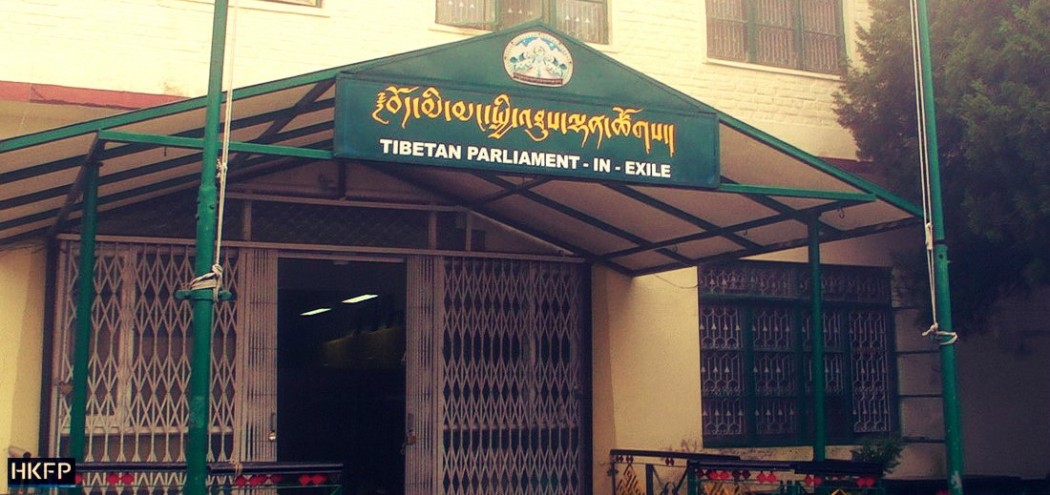
Despite the six decades of generosity that India has shown to the Tibetans, even allowing them to establish their own Parliament on Indian soil, the leadership in Dharamsala have done nothing but abuse His Holiness the Dalai Lama’s name and reputation for decades, to line their own pockets, eliminate their political opponents and otherwise bolster their own self-serving behaviors.
Globally, there is an unprecedented level of trust in His Holiness the Dalai Lama. Political and religious leaders regularly cite him as an outstanding example of unquestionable honesty and integrity, as someone whose words can be trusted and believed. This reputation has, quite undeservingly, filtered down to the rest of the Tibetan leadership who have long been painted as an underdog fighting the might of the Chinese leadership.
But it is precisely this reputation that the CTA have been abusing for the last 60 years, to the detriment of their Tibetan people. Instead of developing political and thought leaders who are capable of driving the negotiating process with China, the Tibetan leadership have taught their people to become beggars lying in wait for a handout from the world. Thinkers and intellectuals like Jamyang Norbu have had their free speech brutally suppressed; potential leaders and politicians like Lukar Jam have had their chances of leadership violently discouraged.
Anyone else who dares think or believe differently from the Tibetan leadership, like Dorje Shugden practitioners, are turned into pariahs. Those who ever dare to express a different point-of-view from the Tibetan leadership are stigmatised as anti-Dalai Lama, and they have riots and mobs set against them. They are threatened with violence, beaten and stabbed, driven from their homes, have their properties vandalized and destroyed, watch their children get bullied in school, are refused medical treatment and even kicked out from their jobs.
The fact that the Dalai Lama’s name is used to turn a community against someone, is proof that the Dalai Lama’s name is the only one with power in the Tibetan community. How come no one is accused of being ‘anti-Lobsang Sangay’ or ‘anti-Samdhong Rinpoche’? The fact is that no other name bears as much influence and weight in the Tibetan community; everything is measured against the Dalai Lama’s opinions and decisions, and not the Tibetan leadership’s or Parliament’s.
The Tibetan leadership have, in effect, been abusing the Dalai Lama’s name to alienate many forward-thinking progressives capable of modernising the Tibetan community ready for the 21st Century. So even if people are passionate about Tibet and about improving the welfare of the exiled community, over time they are forced to set their passion aside and fall in line with the narrow thinking of the leadership.
In this way, the Tibetan leadership have also been abusing the Dalai Lama for the last 60 years, by forcing him over and over again to work hard for Tibet while the leadership and people sit idly by and do nothing. The leadership have taught their people that it is okay to push the entire burden of the so-called Tibetan cause, and the entire weight of the Tibetan people’s expectations onto the Dalai Lama’s shoulders.
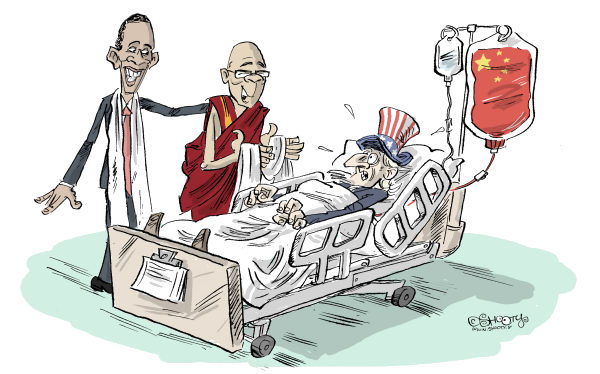
The Tibetan leadership forces His Holiness the Dalai Lama to beg for assistance. Yet, despite millions of dollars received in financial aid, the Tibetan leadership have done very little to convert this assistance into actual, tangible results for their people. So it would seem that the Dalai Lama’s work for the last 60 years has been utterly in vain.
Is this how the Tibetan people profess their so-called love and devotion for the Dalai Lama, by relying on him to single-handedly achieve all Tibetan political goals? Give the 82-year-old monk a break. Where most people would be happily retired by this age, going off to do retreats and deeper meditational practices, the Tibetan leadership continue to cruelly parade the Dalai Lama around the world to drum up support for their ’cause’. In their laziness and selfishness, the Tibetan leadership have turned His Holiness the Dalai Lama into a punchline, forcing him to kowtow to Western powers for money and awareness of the so-called Tibetan cause.
So almost rather naively, the international community have forgotten that the Tibetan leadership is run by many hands who are not ordained, who are not monks, or who are not required or expected to be kind by virtue of their vows. But that was in the last 60 years and slowly, we are seeing signs of change. Countries are rejecting meetings with the Dalai Lama and refusing him entry, and even refusing entry to Tibetan would-be asylum seekers. Predictably, the Tibetan leadership are very unhappy about this. When countries start to value their own relationship with China over the CTA’s trouble-making schemes, the Tibetan leadership cries foul, claiming abuse and disrespect of human rights.

Narendra Modi (Prime Minister of India) and Xi Jinping (President of China) greet one another. Why should the two countries have an antagonistic relationship just because the Tibetan leadership will not benefit from this? The average Indian citizen should not have to suffer from India-China hostilities which are consistently provoked by the Tibetan leadership’s protests against Beijing. India should not have to bend to the Tibetan leadership’s definition of human rights.
But why are these countries forced to bend to the Tibetan leadership’s definition of human rights? Why are they forced to respect the Dalai Lama? What about their own citizens’ human rights to have economic opportunities and financial stability, and a better standard of living, all of which can be gained with a positive relationship with China? It is a clear sign that instead of relying on their intellect, negotiating ability and political skill, the Tibetan leadership have lazily relied on the Dalai Lama’s status as an international symbol of compassion. And when this is no longer enough, they have little to fall back on apart from bleating about how countries have been bullied into submission by China.
This lack of options after 60 years embodies the laziness and complacency that defines the Tibetan leadership. No other refugee community in the world has received as much benefits and consistent financial support as the Tibetans, not the refugee community in the Darfur, not the Rohingyas in Burma, and not the Nepali community suffering statelessness in Bhutan. Europe consistently rejects Syrians, and Australia runs controversial detention centres in Papua New Guinea and Nauru for asylum seekers. But Tibetans are always welcome; wherever they are in the world, the Tibetans are always warmly received with open arms and masses of sympathy and financial assistance. Shockingly however, no other refugee community has received so much aid and accomplished so little despite all of this help.
What is the difference between the suffering refugee communities elsewhere in the world, and suffering Tibetans if not the fact the Tibetans have the charismatic Dalai Lama? Darfur, Rohingyas, stateless ethnic Nepalis all lack this singular figurehead that the world can identify with their cause.
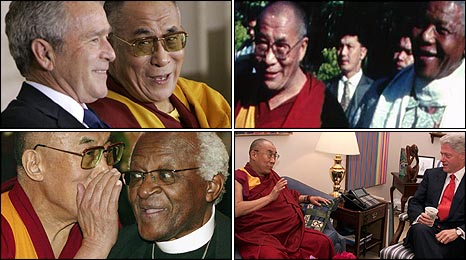
It is always the Dalai Lama meeting various world leaders that generates the headlines, and never Samdhong Rinpoche or Lobsang Sangay meeting with them as an equal. Seen here is His Holiness meeting with (top row) former US President George W. Bush and Nobel Peace Prize laureate Nelson Mandela, and (bottom row) Archibishop Desmond Tutu and former US President Bill Clinton.
And that is precisely what should frighten the CTA the most. They should contemplate on whose name fills the headlines and, as a result, their wallets. When the Dalai Lama travels and meets with foreign dignitaries, it is almost to be expected that these meetings with lead to some kind of headlines and news coverage, and (usually empty) promises of political assistance. After 60 years and a succession of leaders from Samdhong Rinpoche to, more recently, Sikyong Lobsang Sangay, no other personality or office bearer in the Tibetan leadership generates as much headlines as the Dalai Lama. Even in India, the headquarters of the Tibetan diaspora, news headlines are focused on the Dalai Lama and not on the appointed leader of the Tibetan community, the Tibetan Prime Minister Sikyong Lobsang Sangay.
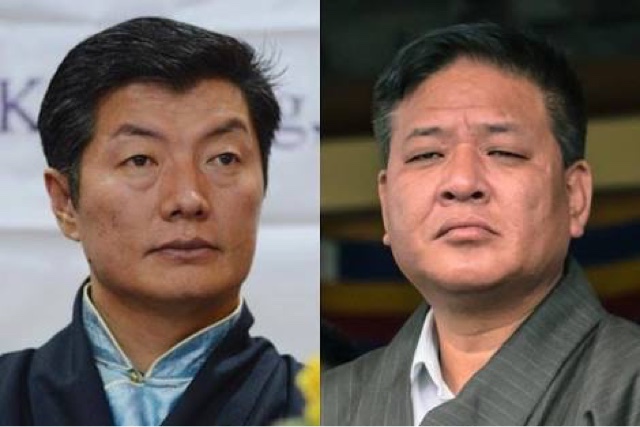
How many people outside of the Tibetan community would really know who these two gentlemen are? If the names and faces of these two leaders are not as universally familiar as the Dalai Lama’s, something has gone very wrong in the Tibetan leadership’s efforts to safeguard the future of their people.
This is a clear sign that globally, the international community is not interested in Samdhong Rinpoche, Lobsang Sangay or anyone else. Despite Lobsang Sangay’s extensive international tour schedule, these appointed leaders are seen merely as emissaries of the Dalai Lama and in fact, independently of the Dalai Lama, no government really cares or has a sustained, proactive interest in the Tibetan community or plight. This is something that the Tibetan leadership, and especially Sikyong Lobsang Sangay, need to seriously reflect on. Obviously they are lacking in something that causes the world to fall in love with the Dalai Lama and not with them, and when the Dalai Lama is no longer with us, there will be no one left to lead the charge for the Tibetan leadership to generate awareness of the so-called Tibetan cause.
The Tibetan leadership also needs to consider if world leaders actually interested in the Dalai Lama as a person, as a spiritual mentor or as a political chess piece to be manipulated in power games against China. By over-relying on His Holiness as the face of their movement and struggle, and by exploiting his godlike status to suppress their enemies, the Tibetan leadership have turned His Holiness into a parody of his real role as a spiritual guide for millions of Tibetans.
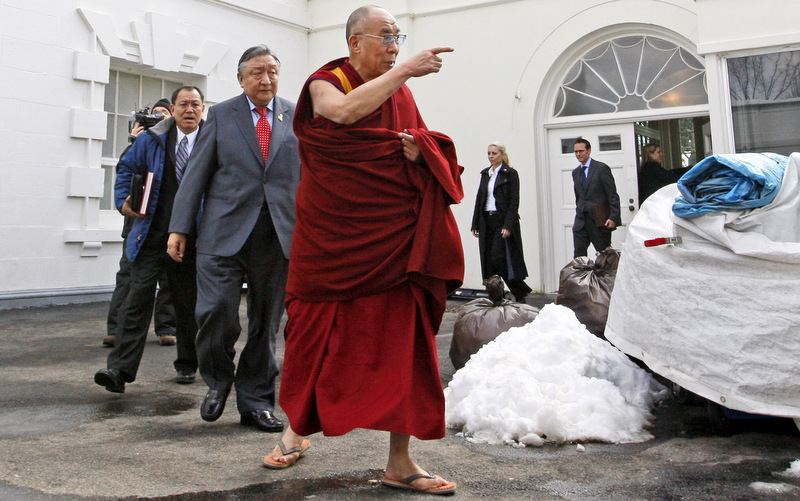
His Holiness the Dalai Lama walks out the back door of the White House in Washington, after meeting with former US President Barack Obama. Is the international community’s respect for the Dalai Lama actually based on his true role as a spiritual mentor, or as a political chess piece to be manipulated against China? Is this really how you show genuine respect to someone, by showing them out the back door? There are doubts that someone like Nelson Mandela would receive the same treatment.
No one is more acutely aware of this than those who are marginalized, suppressed and ostracized by the Tibetan leadership. Tibetan Dorje Shugden practitioners, for example, would love to be reunited with the Dalai Lama and receive teachings from him, and be assimilated back into the rest of the Tibetan community. Many of them would love to view the Dalai Lama as what he really is – the historical spiritual guide for their community – but they are forced to stay away by a leadership who has made it a point to actively discriminate against them for the last 20 years. And so Dorje Shugden devotees remain torn – continue to respect the Dalai Lama as they have done for centuries, or relate to him as the spiritual leader who has imposed this ban against their religion and faith. Meanwhile, the Tibetan leadership stands by and watches silently, content to exercise their prejudice by violently imposing the ban whilst simultaneously doing little to repatriate the Dalai Lama’s reputation in the eyes of those who hold him responsible for this discrimination against them. Hence, in all levels and in all aspects, the Tibetan leadership abuses the Dalai Lama, using him to raise money and using him to justify their abuse and agenda-driven discrimination of their enemies.
At a time when the Tibetan community is so deeply divided over so many issues, and the leadership continues to lumber on in their abuse of the Dalai Lama’s name, the so-called Tibetan dream and everything that the exiled community hopes for seems to be moving further and further away than ever.
MORE NEWS LIKE THIS